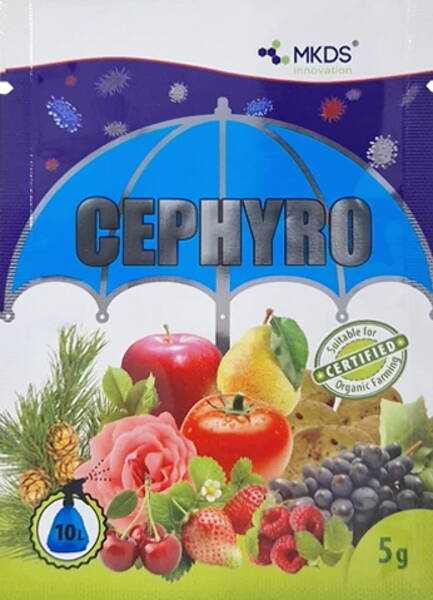Increases resistance to fungal diseases of plants, yield and quality of products!
SUITABLE FOR USE IN ORGANIC FARMING.
The basis of the composition of Cephyro is active copper, which has a rapid effect on plants and is used to prevent and reduce stress caused by abiotic factors.
This copper-containing preparation is recommended for use in treating plants to prevent the following symptoms: chlorosis (discoloration of leaves, shoots, stems), deformation, white and gray coating, spots, drying and falling of leaves, necrosis (dying, blackening of tissues or parts of the plant), falling of needles of gymnosperms (conifers), drying of branches, brown coating, browning, etc.
Attention: do not spray Cephyro during flowering and during fruit ripening. Do not exceed the application rate.
Dilution rate: 5 g/10 l.
Consumption rate: 10 l of /100 m2.
* Copper plays a major role in photosynthesis. It is involved in the metabolism of proteins and carbohydrates. Under the influence of copper, enzymes are activated that prevent the destruction of plant cells. A characteristic feature of copper is that this microelement increases plant resistance to fungal and bacterial diseases. It helps eliminate the negative factors caused by its deficiency, promotes better plant development, increases yields, and significantly improves product quality.
Preparation of the solution: dissolve 5 g of chelate in 10 liters of water until completely dissolved.
Spraying: consumption of 1 liter of solution per 10 square meters. As a preventive measure against diseases, spray once a season (in the initial period of vegetation "tillering"). In case of copper deficiency, spray 2-3 times a season.
Watering (main) is done before digging the soil in the fall or in the spring 2 weeks before planting.
How to use on a large scale?
Foliar spray:
Fruit trees: 50 g/100 l (maximum rate: 0.5 kg/ha) during the growing season. Apply a maximum of four times.
Vineyards: 100 g/100 l (maximum rate: 1 kg/ha) during harvest, if necessary or as a preventive measure.
Walnuts: 100 g/100 l (maximum rate: 1 kg/ha) every 15 days during the entire harvest cycle.
Berries: 100 g/100 l (maximum rate: 0.5 kg/ha) every 10–15 days, from flowering to harvest. Apply a maximum of five times.
Tomatoes: 50–100 g/100 l (maximum rate: 0.5 kg/ha) every 10–15 days from post-flowering until harvest.
Lettuce: 50 g/100 l (maximum rate: 0.5 kg/ha), from the fourth leaf until harvest. Apply a maximum of four times.
Potatoes: 50–100 g/100 l (maximum rate: 0.5 kg/ha), from emergence until harvest. Apply a maximum of five times.












